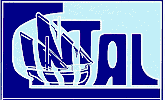|
You are not Logged in! Log in to check your messages. |

|
|
Check todays hot topics |
Web2Project Sign in
Project NUACE

Non-cooperant Underwater Acoustic Channel Estimation (NUACE)
NUACE (project POSI/CPS/47824/2002) aims at developing, testing and validating environmental based techniques for determining the underwater channel impulse response for matched-filtering and channel equalization usage in MFP and Time-Reversal methods. Applications sought are target detection and localization as well as underwater communications. This project is funded by FCT under POSI programme , with 97.5 kEuro for 3 years.Starting date: January 1st, 2004 (lately extended for 8 extra months until August 31st, 2007).
Abstract:
Channel estimation is a common problem to many fields of research and, in particular, in underwater acoustics where the received signal is prone to severe time-space variability, strong multipath, dispersion and reverberation. Classical deconvolution methods attempt to estimate the parametric filter that best matches the medium response to a test input signal. These approaches mainly suffer from two well known drawbacks: one is the need for a known input signal, thus reducing its practical feasibility and efficiency and, two, is that the estimation process is started from scratch at each single environmental or geometric change between source and receiver(s), what makes it extremely slow. This project intends to develop and test the experimental feasibility of environmental model-based methods to estimate the channel impulse response. Environmental model-based techniques are drawn from physical representations of the medium of propagation through the solution of the wave equation and boundary conditions. Searching for the environmental parameters that provide the best fit between the model-based replicas and the actual received signal can be viewed from three advantageous aspects: one is that there is no need for a known (deterministic) excitation of the medium, so the identification can be performed in a blind fashion, two, is that the search is reduced to the space covered by the solutions of the wave equation thus, in principle closer to the true solution and three, each identified parameter has a physical meaning thus providing simultaneously, a possibility for including a priori information of its evolution in time and space, and an estimate of the physical medium itself with all its implications. A key aspect to be brought up in this project is that there is good evidence that signal and noise do propagate through the same channel, therefore noise acquires some modal structure and the signal gets a stochastic aspect. That explains the fact that, in a recent analysis of single hydrophone experimental data, it was found that the signal was confined to a subspace with a much smaller dimension than the expected dimension given by the model. Thus, taking advantage of this experimental fact, putting together the information at each hydrophone throughout the array would be one of the goals of this project. In order to fullfil the project objectives, developing model-based techniques requires access to experimental facilities and actual at sea data. Therefore this project includes the at sea deployment of existing equipment, such as a 16-hydrophone vertical line array and an acoustic sound source, at fixed locations along the Portuguese coast, for listening both to controlled and uncontrolled sound sources (such as ships of opportunity) in various geometric configurations, along variable range-dependent and range-independent propagation transects and frequency bands.
Objectives:
The NUACE project aims at developing array processing techniques for environmental blind model-based estimation of the underwater acoustic channel impulse response. The objectives of the NUACE project can be summarized as follows:
 to develop optimization
techniques for blind estimation of the environmental
parameters that "focus" the source position and received to model data fitness.
These parameters would provide the environmentally optimum channel impulse response
at a given sensor;
to develop optimization
techniques for blind estimation of the environmental
parameters that "focus" the source position and received to model data fitness.
These parameters would provide the environmentally optimum channel impulse response
at a given sensor;  extend that environmentally
optimum channel impulse response to an array
impulse response, by identifying the signal subspace at each sensor and subspace
tracking throughout the sensor array;
extend that environmentally
optimum channel impulse response to an array
impulse response, by identifying the signal subspace at each sensor and subspace
tracking throughout the sensor array;  to test these techniques
on at sea collected data, both under controlled
and uncontrolled environments, for applications such as underwater communications,
source localization and ocean acoustic tomography.
to test these techniques
on at sea collected data, both under controlled
and uncontrolled environments, for applications such as underwater communications,
source localization and ocean acoustic tomography.
